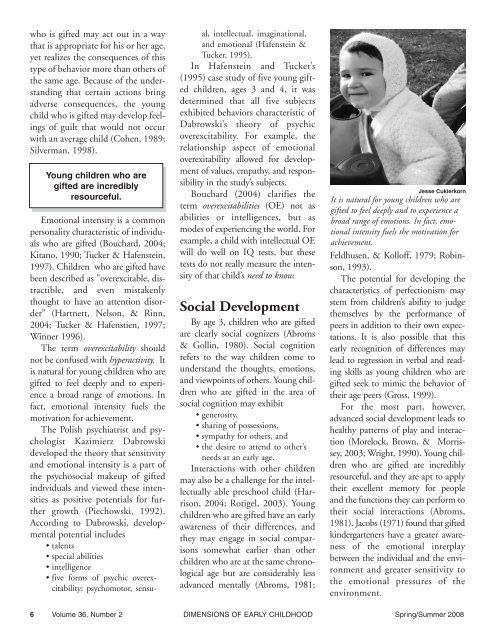Recognizing Giftedness: Defining High Ability in Young Children
Recognizing Giftedness: Defining High Ability in Young Children
Recognizing Giftedness: Defining High Ability in Young Children
You also want an ePaper? Increase the reach of your titles
YUMPU automatically turns print PDFs into web optimized ePapers that Google loves.
who is gifted may act out <strong>in</strong> a way<br />
that is appropriate for his or her age,<br />
yet realizes the consequences of this<br />
type of behavior more than others of<br />
the same age. Because of the understand<strong>in</strong>g<br />
that certa<strong>in</strong> actions br<strong>in</strong>g<br />
adverse consequences, the young<br />
child who is gifted may develop feel<strong>in</strong>gs<br />
of guilt that would not occur<br />
with an average child (Cohen, 1989;<br />
Silverman, 1998).<br />
<strong>Young</strong> children who are<br />
gifted are <strong>in</strong>credibly<br />
resourceful.<br />
Emotional <strong>in</strong>tensity is a common<br />
personality characteristic of <strong>in</strong>dividuals<br />
who are gifted (Bouchard, 2004;<br />
Kitano, 1990; Tucker & Hafenste<strong>in</strong>,<br />
1997). <strong>Children</strong> who are gifted have<br />
been described as "overexcitable, distractible,<br />
and even mistakenly<br />
thought to have an attention disorder”<br />
(Hartnett, Nelson, & R<strong>in</strong>n,<br />
2004; Tucker & Hafenstien, 1997;<br />
W<strong>in</strong>ner 1996).<br />
The term overexcitability should<br />
not be confused with hyperactivity. It<br />
is natural for young children who are<br />
gifted to feel deeply and to experience<br />
a broad range of emotions. In<br />
fact, emotional <strong>in</strong>tensity fuels the<br />
motivation for achievement.<br />
The Polish psychiatrist and psychologist<br />
Kazimierz Dabrowski<br />
developed the theory that sensitivity<br />
and emotional <strong>in</strong>tensity is a part of<br />
the psychosocial makeup of gifted<br />
<strong>in</strong>dividuals and viewed these <strong>in</strong>tensities<br />
as positive potentials for further<br />
growth (Piechowski, 1992).<br />
Accord<strong>in</strong>g to Dabrowski, developmental<br />
potential <strong>in</strong>cludes<br />
• talents<br />
• special abilities<br />
• <strong>in</strong>telligence<br />
• five forms of psychic overexcitability:<br />
psychomotor, sensual,<br />
<strong>in</strong>tellectual, imag<strong>in</strong>ational,<br />
and emotional (Hafenste<strong>in</strong> &<br />
Tucker, 1995).<br />
In Hafenste<strong>in</strong> and Tucker’s<br />
(1995) case study of five young gifted<br />
children, ages 3 and 4, it was<br />
determ<strong>in</strong>ed that all five subjects<br />
exhibited behaviors characteristic of<br />
Dabrowski’s theory of psychic<br />
overexcitability. For example, the<br />
relationship aspect of emotional<br />
overexitability allowed for development<br />
of values, empathy, and responsibility<br />
<strong>in</strong> the study’s subjects.<br />
Bouchard (2004) clarifies the<br />
term overexcitabilities (OE) not as<br />
abilities or <strong>in</strong>telligences, but as<br />
modes of experienc<strong>in</strong>g the world. For<br />
example, a child with <strong>in</strong>tellectual OE<br />
will do well on IQ tests, but these<br />
tests do not really measure the <strong>in</strong>tensity<br />
of that child’s need to know.<br />
Social Development<br />
By age 3, children who are gifted<br />
are clearly social cognizers (Abroms<br />
& Goll<strong>in</strong>, 1980). Social cognition<br />
refers to the way children come to<br />
understand the thoughts, emotions,<br />
and viewpo<strong>in</strong>ts of others. <strong>Young</strong> children<br />
who are gifted <strong>in</strong> the area of<br />
social cognition may exhibit<br />
• generosity,<br />
• shar<strong>in</strong>g of possessions,<br />
• sympathy for others, and<br />
• the desire to attend to other’s<br />
needs at an early age.<br />
Interactions with other children<br />
may also be a challenge for the <strong>in</strong>tellectually<br />
able preschool child (Harrison,<br />
2004; Rotigel, 2003). <strong>Young</strong><br />
children who are gifted have an early<br />
awareness of their differences, and<br />
they may engage <strong>in</strong> social comparisons<br />
somewhat earlier than other<br />
children who are at the same chronological<br />
age but are considerably less<br />
advanced mentally (Abroms, 1981;<br />
Jesse Cukierkorn<br />
It is natural for young children who are<br />
gifted to feel deeply and to experience a<br />
broad range of emotions. In fact, emotional<br />
<strong>in</strong>tensity fuels the motivation for<br />
achievement.<br />
Feldhusen, & Kolloff, 1979; Rob<strong>in</strong>son,<br />
1993).<br />
The potential for develop<strong>in</strong>g the<br />
characteristics of perfectionism may<br />
stem from children’s ability to judge<br />
themselves by the performance of<br />
peers <strong>in</strong> addition to their own expectations.<br />
It is also possible that this<br />
early recognition of differences may<br />
lead to regression <strong>in</strong> verbal and read<strong>in</strong>g<br />
skills as young children who are<br />
gifted seek to mimic the behavior of<br />
their age peers (Gross, 1999).<br />
For the most part, however,<br />
advanced social development leads to<br />
healthy patterns of play and <strong>in</strong>teraction<br />
(Morelock, Brown, & Morrissey,<br />
2003; Wright, 1990). <strong>Young</strong> children<br />
who are gifted are <strong>in</strong>credibly<br />
resourceful, and they are apt to apply<br />
their excellent memory for people<br />
and the functions they can perform to<br />
their social <strong>in</strong>teractions (Abroms,<br />
1981). Jacobs (1971) found that gifted<br />
k<strong>in</strong>dergarteners have a greater awareness<br />
of the emotional <strong>in</strong>terplay<br />
between the <strong>in</strong>dividual and the environment<br />
and greater sensitivity to<br />
the emotional pressures of the<br />
environment.<br />
6 Volume 36, Number 2 DIMENSIONS OF EARLY CHILDHOOD Spr<strong>in</strong>g/Summer 2008
















